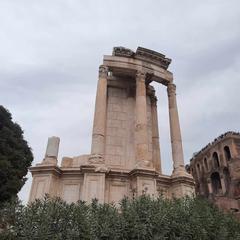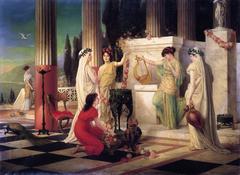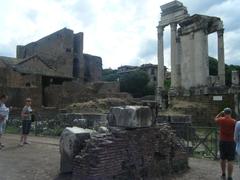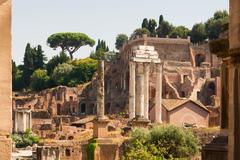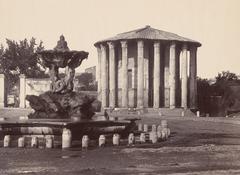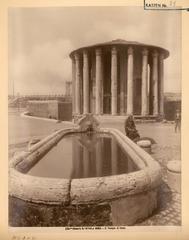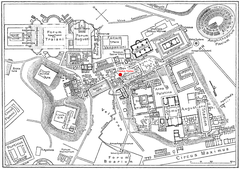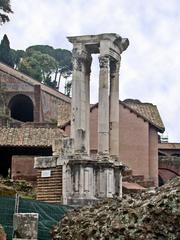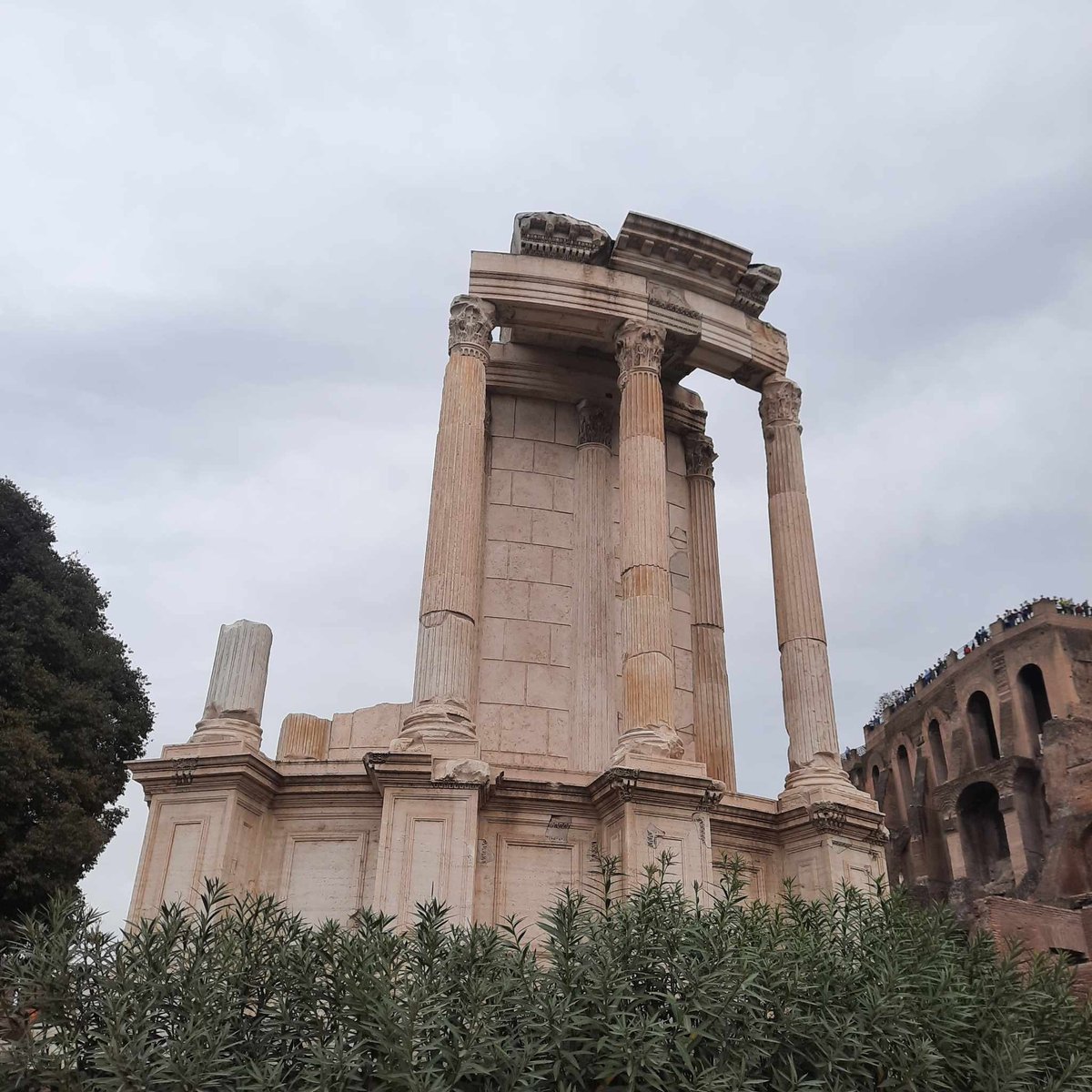
Temple of Vesta, Rome: Visiting Hours, Tickets, and Historical Guide
Date: 14/06/2025
Introduction
Nestled in the heart of the Roman Forum, the Temple of Vesta stands as a testament to Rome’s ancient spirituality, civic life, and architectural ingenuity. Unlike most Roman temples, this shrine’s circular design represents the primordial hearth — the symbolic heart of both home and city. Here, the Vestal Virgins tended the eternal flame, safeguarding Rome’s fortune and embodying the ideals of purity and civic duty. This guide provides an in-depth look at the temple’s history, architecture, visiting details, and practical advice for travelers.
For comprehensive historical context, visitor information, and images, consult resources such as Wikipedia, ItalyTravel101, and The Travel.
Table of Contents
- Early Origins and Construction
- Religious and Civic Significance
- Architectural Evolution and Restoration
- Decline and Rediscovery
- Visiting the Temple of Vesta: Hours, Tickets, and Tips
- Nearby Sites and Practical Information
- FAQs
- Summary and Final Tips
- References
Early Origins and Construction
The Temple of Vesta (Aedes Vestae) is one of Rome’s most ancient and revered monuments. Traditionally attributed to King Numa Pompilius in the early 7th century BCE, it was the primary seat of the cult of Vesta, goddess of the hearth (Wikipedia). The original structure was inspired by early Italic round huts, symbolizing both the domestic and civic hearth, with the entrance facing east to greet the rising sun (visit-colosseum-rome.com).
The building’s unique circular form, about 15 meters in diameter, set it apart from the rectangular temples typical of Roman architecture. The initial versions were constructed of wood and straw, making them vulnerable to fire — a recurring hazard that shaped the temple’s long history (visit-colosseum-rome.com).
Religious and Civic Significance
More than an architectural marvel, the Temple of Vesta was the spiritual heart of Rome. Its eternal flame, kept alive by the Vestal Virgins, was considered the city’s life force. The Vestals, chosen as children from patrician families, served 30 years in chastity and held unique privileges, including legal independence and influence in public affairs (roman-empire.net).
The sacred fire’s extinction was viewed as a catastrophe, portending doom for Rome. The temple also safeguarded critical state documents and cult objects, including the Palladium, a symbol of Rome’s divine protection (Wikipedia). The temple’s location near the Regia and the House of the Vestal Virgins underlined its centrality in both the spiritual and political life of the city (ItalyTravel101).
Architectural Evolution and Restoration
Repeated fires led to several reconstructions, with the most significant rebuilds in 64 CE (after the great fire under Nero), and in the 3rd century CE under Julia Domna, wife of Septimius Severus (Wikipedia). The Severan reconstruction introduced white marble Corinthian columns and a conical, vented roof, allowing smoke from the sacred flame to escape (visit-colosseum-rome.com).
The interior was a simple, open chamber with the sacred hearth at its center. The roof’s oculus provided essential ventilation but increased fire risk. The temple’s design was a blend of Italic tradition and Greek elegance, symbolizing Rome’s cultural synthesis (visit-colosseum-rome.com).
In the 16th century, much of the marble was repurposed for new buildings. Modern archaeology, beginning in the late 19th century, led to partial reconstructions visible today, most notably in 1931 (visit-colosseum-rome.com).
Decline and Rediscovery
The temple’s decline followed the end of paganism in the late Roman Empire. In 394 CE, Emperor Theodosius I ordered the extinction of the sacred fire, ending the Vestal order and the temple’s religious role (Wikipedia). The building gradually deteriorated, its stones and marbles scavenged for other uses.
Excavations in the late 19th and early 20th centuries uncovered much of what is visible today. Reconstructions, guided by archaeological research and ancient depictions, have restored some columns and the podium, helping visitors imagine the temple’s former grandeur (Wikipedia).
Visiting the Temple of Vesta: Hours, Tickets, and Tips
Location and Access
The temple is located within the Roman Forum, accessible from Via dei Fori Imperiali. The closest metro station is Colosseo (Metro Line B), a 10-minute walk from the Forum entrance (Tripomatic). Entry is via the Via Sacra, passing the Arch of Titus. Comfortable shoes are recommended due to uneven ancient paving (Rome Info).
Visiting Hours
- Last Sunday in October – February 15: 8:30 am – 4:30 pm
- February 16 – March 15: 8:30 am – 5:00 pm
- March 16 – last Saturday in March: 8:30 am – 5:30 pm
- Last Sunday in March – August 31: 8:30 am – 7:15 pm
- September 1 – September 30: 8:30 am – 7:00 pm
- October 1 – October 24: 8:30 am – 6:30 pm
Last admission is one hour before closing. Closed January 1, May 1, and December 25. Always check the official website for updates (Tripomatic).
Tickets and Entry
Admission is included in the combined ticket for the Colosseum, Roman Forum, and Palatine Hill:
- Adults: €12
- EU citizens (18–25): €7.50
- Online reservation fee: €2
Purchase tickets on-site or online for skip-the-line access (Italy Tourist Information).
Accessibility
The Forum has uneven terrain and limited ramps. Some paths are accessible, but others may be challenging for those with mobility impairments. Contact the site in advance for specific accessibility advice (Rome Info).
Guided Tours and Interpretation
Guided tours provide expert insights into the temple’s role in Roman religion and society. Book tours in advance for skip-the-line entry and deeper understanding. Audio guides and on-site panels are also available (Italy Tourist Information), (Tripomatic).
Facilities
- Restrooms are located at Forum entrances.
- No cafes or restaurants inside; bring water and snacks.
- Potable water is available near the Arch of Titus.
Nearby Sites and Practical Information
Adjacent Structures
- House of the Vestal Virgins: The residence of the six priestesses, with serene courtyards and statues (madainproject.com).
- Temple of Castor and Pollux: Recognizable by three standing columns (paulpassingthrough.com).
- Temple of Antoninus and Faustina: Well-preserved facade just west of Vesta (italyguides.it).
- Arch of Titus: Triumphal arch at the Forum’s eastern end (theromanguy.com).
Practical Tips
- Visit in spring (April–June) or early autumn (September–October) for mild weather and fewer crowds (HelloMondo).
- Arrive early or late for the best light and comfort.
- Wear sturdy shoes and bring sun protection.
- Check for special events such as historical reenactments.
- Respect all site rules and stay on marked paths.
Frequently Asked Questions (FAQ)
Q: What are the Temple of Vesta’s opening hours?
A: Open daily, with hours varying by season (generally 8:30 am to 4:30–7:15 pm). Always check the latest schedule on the official site.
Q: How much are tickets?
A: Entry is included in the combined ticket with the Colosseum and Palatine Hill. Adults €12, EU citizens (18–25) €7.50, plus €2 online fee.
Q: Is the site accessible?
A: Some accessible paths exist, but uneven ground may pose challenges. Contact the site in advance for details.
Q: Are guided tours available?
A: Yes, guided tours and audio guides are widely available and recommended.
Q: What is the best time to visit?
A: Spring and early autumn for pleasant weather and lighter crowds; early mornings or late afternoons for the best experience.
Summary and Final Tips
The Temple of Vesta is a remarkable symbol of Rome’s spiritual and civic legacy. Its unique architecture, the mysteries of the Vestal Virgins, and its storied place in the Roman Forum make it an essential stop for history enthusiasts and travelers alike. To maximize your visit:
- Purchase tickets in advance.
- Combine your visit with the Forum and Palatine Hill for a full day of exploration.
- Consider a guided tour for enriched context.
- Travel light, wear comfortable shoes, and check the latest visitor information before arrival.
For more details, updates, and exclusive audio guides, download the Audiala app and follow us on social media.
References
- Wikipedia: Temple of Vesta
- ItalyTravel101: Roman Forum and Palatine Hill Guide
- The Travel: Can You Visit the Temple of Vesta Rome?
- roman.mythologyworldwide.com: The Mysteries Surrounding the Temple of Vesta
- roman-empire.net: The Vestal Virgins
- visit-colosseum-rome.com: Temple of Vesta
- madainproject.com: House of the Vestals
- paulpassingthrough.com: The Roman Forum and Palatine Hill
- Tripomatic: Temple of Vesta
- officialrome.info: Roman Forum
- Parco Archeologico del Colosseo
- Italy Tourist Information: Roman Forum & Palatine Hill
- Rome Info: Roman Forum
- HelloMondo: Temple of Vesta
- italyguides.it: Roman Forum Map
- theromanguy.com: Guide to the Best Ruins in Rome
